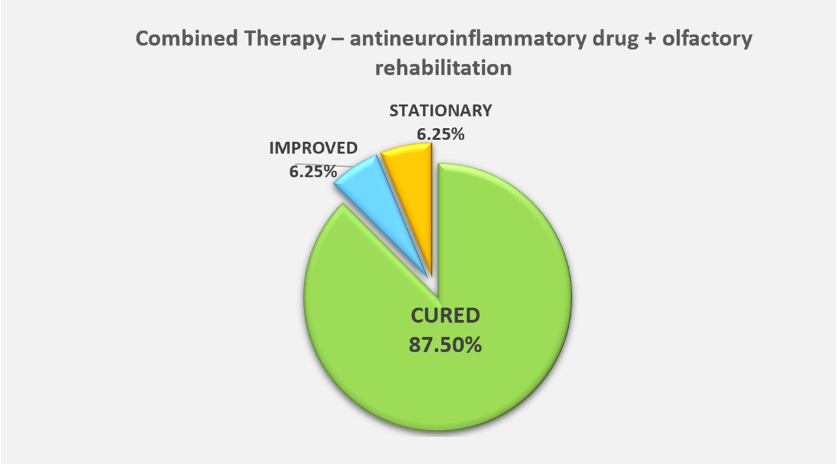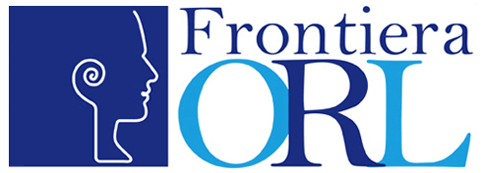COVID-19 ANOSMIA. FIRST RESULTS WITH OLFACTORY REHABILITATION (SMELL THERAPY)
NICOLA TAUROZZI, MAHMOUD ABOU MERHI
Operating Unit of Otolaryngology of the Hesperia Hospital (high specialty center) Modena (Italy)
Address all correspondence to: Nicola Taurozzi Hesperia Hospital Via Arquà 80/A
41125 Modena (Italy) telephone: 059 449111. Cell. 340 6906395 E-mail: nicolataurozzi@gmail.com
Keywords: Covid-19 anosmia, olfactory rehabilitation (smell therapy)
ABSTRACT
Aims of the study. In the treatment of Covid-19 anosmia, compare the results of two therapeutic approaches: one only of a pharmacological type and one with combined therapy: drug + olfactory rehabilitation (smell therapy).
Materials and methods. In the period from March 2020 to April 2021 we enrolled 31 paucisymptomatic subjects, affected by Covid-19 anosmia, for over 60 days. A sample of 15 subjects was treated with only the anti-inflammatory drug therapy (alpha lipoic acid and palmitoylethanolamide) while the second sample of 16 subjects underwent anti-neuro-inflammatory drug therapy associated with olfactory rehabilitation (smell Therapy). The olfactory rehabilitation consisted in inviting the subjects to train their olfactory apparatus by “sniffing” a series of 4 essential oils that emit intense and persistent odors, alternately for 30 seconds, 3 times a day for the duration of 30 days.
Results. Combined drug therapy and olfactory rehabilitation (smell Therapy) made it possible to achieve cure of Covid-19 anosmia in 87.5% of cases after 30 days of treatment, with an increase in the cure rate of 47.5% compared to to treatment with drug therapy alone.
INTRODUCTION
Comparative clinical studies show that 65% of the persons who contract the SARS-CoV-2 virus are affected by anosmia, frequently associated with ageusia. A recent English study has found that 49% of patients affected by Covid-19 anosmia recover their sense of smell within thirty days, 50% continue to experience the symptom beyond 5-6 months, and 1% do not recover their perception of odors after a year.
Fig. 1
NEW PATHOGENESIS OF COVID-19 ANOSMIA

It has been demonstrated by the neurobiologist Robert Datta of the Harvard Medical School in Boston that the Sars-Cov-2 virus does not directly infect the olfactory neurons (Fig. 1), which are devoid of ACE2 receptors. Rather, it indirectly affects the interneural sustentacular support cells, which instead possess ACE2 receptors, thus depriving the olfactory neurons of ‘nourishment’ and making them vulnerable. It is a veritable neurological pathology of the olfactory apparatus (nerve fibers and olfactory bulb). This etiopathogenetic mechanism explains the slow recovery from Covid-19 anosmia compared to anosmias that have other viral causes.
PHARMACOLOGICAL APPROACH CURRENTLY IN USE
There is no codified treatment. Cortisone and anti-neuro-inflammatory supplements such as alpha-lipoic acid and palmitoylethanolamide (PEA) are used, but with conflicting results.
AN EXPERIMENTAL COMBINED THERAPEUTIC APPROACH: PHARMACOLOGICAL AND OLFACTORY REHABILITATION (SMELL THERAPY)
Starting from the anosmia onset mechanism due to the neurological pathogenesis of Covid-19, we hypothesized that, like neurological pathologies, also this kind of anosmia could benefit from a combined treatment, pharmacological and rehabilitative, of a specifically olfactory type.
STUDY MATERIAL AND METHOD
Fig. 2
In the period from March 2020 to April 2021 we enlisted a sample of 31 persons affected by Covid-19 paucisymptomatic anosmia, not hospitalized but treated in our hospital’s outpatient department,
who had suffered from the olfactory disorder for more than 60 days. The patients were divided into two groups. One sample of 15 subjects was treated with anti-inflammatory drug therapy alone: alpha-lipoic acid 600 mg + palmitoylethanolamide 600mg or ultra-micronized PEA for the duration of 30 days. The second sample of 16 subjects underwent combined therapy – pharmacological anti-inflammatory drug + olfactory rehabilitation (smell terapy) – for the same duration of 30 days. For the olfactory rehabilitation therapy, or smell training, we invited the patients to train their olfactory systems by having them ‘smell’ (Fig. 2) a series of four essential oils that emit intense odors, such as eucalyptus, mint, camphor and myrrh (obtainable in small bottles from pharmacies or herbalists), alternately for 30 seconds, 3 times a day for 30 days.
Fig. 2
Covid-19 Anosmia
a series of four essential oils for olfactory rehabilitation
(smell therapy)

RESULTS. Of the first sample of 15 patients treated with drug therapy alone (alpha-lipoic acid + ultra-micronized palmitoylethanolamide), 6 were cured of anosmia (40%), 2 improved (13%), and 7 remained stationary (47%), (Fig. 3). Of the second sample of 16 patients treated with a combined therapy (anti-neuro-inflammatory drug + olfactory training), 14 were cured (87.5%), 1 improved (6.25%), and 1 remained stationary (6.25%), (Fig. 4).
Fig. 3

Fig. 4

FINAL CONSIDERATIONS
Anti-inflammatory drug therapy (alpha-lipoic acid 600 mg + palmitoylethanolamide 600 mg) combined with olfactory training made it possible to achieve recovery from Covid-19 anosmia in 87.5% of cases, after 30 days of treatment, with an approximately 47% increase in the cure rate compared with that obtained with drug therapy alone. The first results, although encouraging and supported by other research on the subject, require further verification by a multicenter study with more extensive sampling.
BIBLIOGRAFY
- Jerome R Lechien 1 2 3 4, Carlos M Chiesa-Estomba 5 6, Daniele R De Siati 5 7, ? Mihaela Horoi 8, and other . Olfactory and gustatory dysfunctions as a clinical presentation of mild-to-moderate forms of the coronavirus disease (COVID-19): a multicenter European study. Eur Arch Otorhinolaryngol. 2020 Aug;277(8):2251-2261. doi: 10.1007/s00405-020-05965-1. Epub 2020 Apr 6.
- Athanasia Printza 1, Jannis Constantinidis 2. The role of self-reported smell and taste disorders in suspected COVID19. Eur Arch Otorhinolaryngol 2020 Sep;277(9):2625-2630. doi: 10.1007/s00405-020-06069-6. Epub 2020 May 23
- Sedaghat AR, Gengler I, Speth M. Olfactory Dysfunction: A Highly Prevalent Symptom of COVID-19 With Public Health Significance. Otolaryngol Head Neck Surg. 2020 Jul;163(1):12-15. doi: 10.1177/0194599820926464. Epub 2020 May 5. PMID:32366160
- Boesveldt S, Postuma Em, Boak D, Welge-Luessen A, and others- Anosmia- A Clinical Review Chem Senses 2017 Sep.1; 42(7) 513.523 doi:10-1093/Chemse/bjx 0252.
- David Brann, Sandeep Robert Datta and others – Non neural expression of Sars-Cov-2 entry genes in the olfactory epithelium suggests mechanisms underljing anosmia in covid 19 patients, Science advances doi:10,1126 /Sciadv.abc 5801.
- Link Mao, Mengdie Wang, Shanghai Chen, Quanwei He – Neurological manifestations of Hospitalized patiens with covid-19 in Wuhan, China, a retrospective case series study-MedRxiv doi: https://doi org/ 10.1101/2020, 02. 22. 200 26500.
- Jafek BW, Ultrastructure of human nasal-Thieme-New York, Stuttgart 1-18.
- Krant Wurst D, Uman olfactory receptor families and their odorants Chem Biodivers 208 Jun 5 (6) 842-52.
- Scangas Ga, Bleier Bs, Anosmia: differential diagnosis, evalutation and management, Am J Rhinol Allergology, 2017, Jan 1 doi: 10 2500/ajra 2017,31.4403

